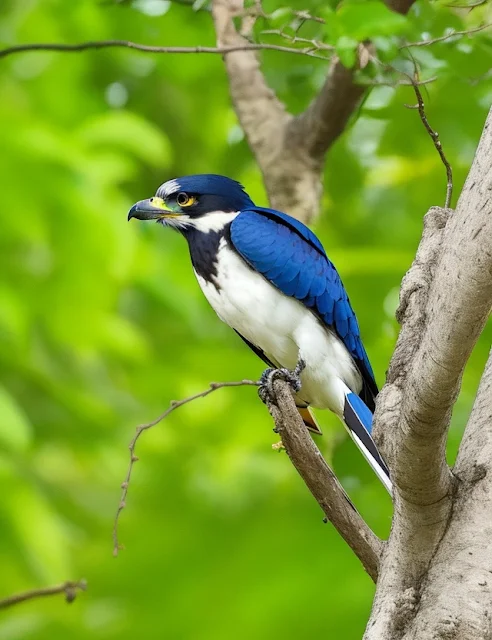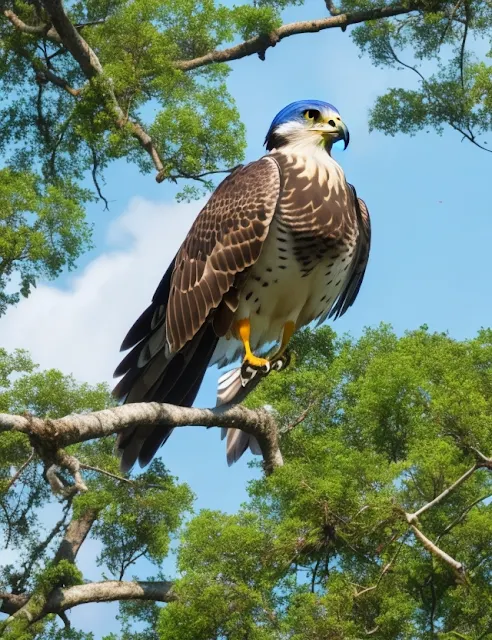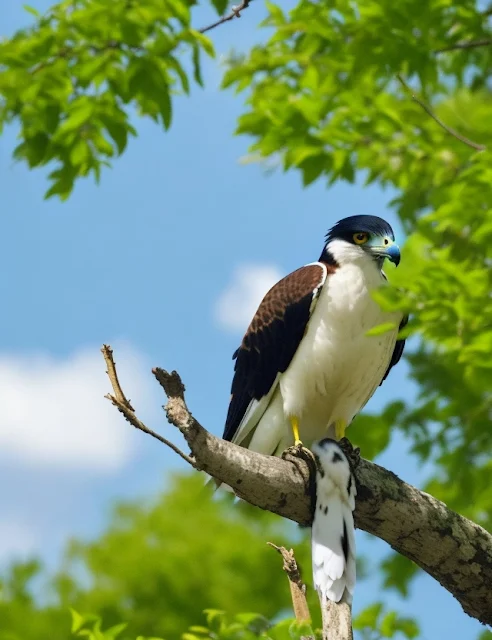How many speceis of Falcon? The part three
Falcon (3/5)
The Bat Falcon
The Bat Falcon is a species of bird native to Central and South America. It is one of the most widespread raptors in its range, found across forests, woodlands, urban areas and other habitats. The Bat Falcon has an impressive wingspan that can reach up to two feet long!
Its body length ranges from 8-10 inches with a tail length between 4-6 inches. The feathers are generally dark brown or black on top with white underneath - giving it an interesting contrast in coloration when viewed from above or below.
The diet of the Bat Falcon consists mainly of bats and small birds which they hunt during twilight hours by flying low over their habitat looking for prey items such as insects, lizards and frogs which they snatch out midair using their short talons!
They also eat fruit occasionally but this does not make up much part of their diet overall since they prefer hunting live prey instead – making them true predators within the ecosystem that helps control pest populations like mosquitos too!
In terms of behavior, these birds tend to be quite territorial so if you see one perched atop a tree branch then chances are there may be more nearby as well – all vying for space within the same area where food sources are plentiful enough for everyone’s needs without having any major conflicts arise between individuals (which can happen sometimes!).
All in all though these fascinating creatures provide us with plenty opportunities just by observing them alone; whether it’s watching how agilely they swoop down upon unsuspecting victims or admiring those beautiful colors against our night sky – we never tire from marveling at nature's wonders every now again then do we?
The Slaty-backed forest falcon
The Slaty-backed forest falcon is a medium-sized raptor native to Central and South America. This species of bird has been classified as Near Threatened by the IUCN Red List due to its decreasing population numbers.
The slaty-backed forest falcon is distinctively marked with greyish brown upperparts, white underparts, black barring on the wings and tail, and a pale yellow bill. It prefers to inhabit humid lowland forests but can also be found in semiopen habitats such as savannas or lightly wooded areas near water sources like rivers or lakes.
This species mainly feeds on small mammals such as rodents but will also take reptiles, amphibians, insects and other birds if necessary for survival. Its hunting technique involves perching above its prey while scanning from high vantage points before swooping down quickly when it locates potential food items below it in the trees or ground coverings nearby.
During breeding season they form monogamous pairs that share duties between them including nest building activities where materials are collected from nearby branches which are then woven together into an intricate bowl shape usually placed within tree cavities around 5 meters off the ground level.
Overall this beautiful bird serves an important ecological role in controlling local rodent populations while providing us with stunning visuals of nature at work! Unfortunately their numbers have been declining due to deforestation activities happening across much of their range so conservation efforts need to be made soon if we want these majestic creatures continue gracing our skies for generations more come!
The Lined Forest Falcon
The Lined Forest Falcon is a species of raptor native to Central and South America. It is one of the few birds that can be found in both rainforest and dry forest habitats, making it an important part of many ecosystems. The Lined Forest Falcon has a distinct look with its white head, chestnut back, barred wings and tail feathers, as well as its black facial mask. This bird also has yellow eyes which are framed by red eye rings.
The diet for this species consists mainly of small mammals such as rodents or bats caught on the wing during mid-air chases; however they will also eat reptiles, amphibians and insects when available. They typically hunt from perches located high up in trees where they have an advantage over their prey due to their sharp vision combined with good aerial maneuverability allowing them to quickly pursue any potential meal items detected below them while flying through the canopy layer above ground level terrain.
Features like rivers or streams providing additional hunting opportunities for these birds who often follow along water sources looking for food items flushed out into open areas near shorelines by larger predators like crocodiles or caiman which share similar aquatic habitat requirements .
In addition to being skilled hunters the Lined Forest Falcons are monogamous breeders meaning that each pair will mate together throughout successive breeding seasons producing clutches containing up two five eggs at each nesting site usually located within tree cavities close enough so parents can easily watch over young hatchlings, until fledging takes place several weeks later after chicks become strong enough fly away independently thus completing another successful reproductive cycle enabling this species population numbers remain stable.
Despite ongoing threats posed human encroachment destruction natural habitat resources needed sustain healthy populations various wildlife communities including those occupied these amazing raptors across much Central South American regions today.
Buckley's Forest Falcon
Buckley's Forest Falcon is a species of bird native to the forests of Central and South America. It is one of the most beautiful birds in its family, with striking black-and-white plumage and bright yellow eyes.
The Buckley’s Forest Falcon prefers humid tropical climates and can often be found near streams or rivers in dense jungles. This species has an impressive wingspan that allows it to soar through the air gracefully, searching for prey such as small mammals or insects.
The Buckley’s Forest Falcon plays an important role in maintaining healthy ecosystems by keeping insect populations under control, which helps prevent disease outbreaks caused by pests like mosquitoes carrying malaria or dengue fever viruses.
Additionally, this species serves as a food source for larger predators like hawks and owls who hunt them from above while they are flying through their habitats looking for food themselves!
Due to habitat destruction caused by deforestation practices throughout its range, this majestic creature is now listed on IUCN Red List as Vulnerable Species meaning that conservation efforts must be made if we hope to keep these incredible birds around into future generations!
Fortunately there are many organizations working hard towards protecting these animals' natural habitats so that they may continue living happily among us - let's all do our part too help ensure their survival!
The Plumbeous Forest Falcon
The Plumbeous Forest Falcon is a species of bird that resides in the tropical forests of Central and South America. It has been classified as near threatened due to its declining population, with only an estimated 10,000 individuals left in the wild.
This medium-sized falcon is known for its striking plumage which features a slate gray body with white underparts and black barring on the wings and tail. The head is also adorned with distinctive white spots on either side of its crown giving it a unique appearance among other raptors.
This species relies heavily upon flying insects such as grasshoppers or dragonflies for food which they can obtain while soaring through their forest habitats at high speeds up to 30 miles per hour! They are also adept hunters who use surprise attacks from above to ambush unsuspecting prey items like small mammals or reptiles before quickly snatching them up in their talons mid-flight!
These birds have even been known to take advantage of manmade structures such as power lines when looking for potential meals by waiting patiently until something passes beneath them before swooping down swiftly towards it’s target!
In addition to being skilled predators, these falcons are highly sociable creatures who often form large flocks during migration season where they will travel together over long distances between different regions searching out more suitable climates depending on the time year.
Furthermore, some pairs have even been observed engaging in cooperative hunting techniques by teaming up against larger prey items like snakes or lizards - making this species one that truly stands out amongst others within its family groupings due largely thanks not only too their impressive hunting abilities but also because how well adapted they are living life both alone & alongside each other alike!
The Cryptic Forest Falcon
The Cryptic Forest Falcon is a species of bird that resides in the tropical forests of Central and South America. It is known for its unique, cryptic coloration and secretive behavior which makes it difficult to spot in its natural environment. This bird has been classified as Near Threatened by the International Union for Conservation of Nature due to deforestation, hunting, and other threats.
The Cryptic Forest Falcon typically lives alone or pairs with a mate during breeding season only. Its diet consists mostly of small mammals such as rodents, lizards, frogs and insects but they will also take larger prey like bats if available.
They hunt by perching on high branches or flying low over open areas searching for their next meal while remaining camouflaged against their surroundings thanks to their mottled brown-gray feathers which provide excellent camouflage from predators below them in the canopy layer beneath them where most predation occurs .
This species can be identified by its distinctive call; a loud “kak-kak” sound that carries through even dense forested areas making it easier to locate than many other birds found within this habitat type. The Cryptic Forest Falcon is an essential part of these ecosystems providing pest control services keeping populations healthy ensuring balance between predator/prey relationships remain intact without disruption from human activities such as hunting or trapping animals within these habitats. By protecting this beautiful creature we are helping protect our own future generations who rely upon healthy balanced ecosystems all around us.
The Black-Thighed Falconet
The Black-Thighed Falconet is a small, Southeast Asian bird of prey. It is one of the smallest known species in its family and has an unmistakable black and white plumage that makes it stand out among other birds. The falconet’s diet consists mainly of insects, though it will also take small reptiles if available. Despite its size, this raptor can be quite aggressive when defending its territory or nesting sites from intruders—even larger birds like hawks!
Black-Thighed Falconets are found primarily in Indonesia but can also be spotted throughout much of Southeast Asia as well as parts of India and Pakistan. They prefer open woodlands with plenty trees for perching or nesting opportunities but have been seen around human settlements too—especially those near bodies water where their insect prey tends to congregate more often than elsewhere.
This adaptability allows them to thrive even in areas with high levels human activity; however they remain vulnerable due habitat loss caused by deforestation or land conversion for agricultural use.
In conclusion, the Black - Thighed Falconet may not seem impressive given their diminutive size compared to other raptors ; however, they are highly capable hunters thanks to their agility and sharp eyesight which enable them spot potential meals from considerable distances away. Furthermore, these little predators have managed survive despite encroachment on habitats by humans —a testament both resourcefulness capabilities survival under challenging conditions.
The Collared Falconet
The Collared Falconet is a small species of bird native to Southeast Asia. It is one of the smallest raptors in the world, measuring only about six inches long and weighing less than two ounces. Despite its diminutive size, it has an impressive wingspan that can reach up to twenty inches wide.
This allows them to maneuver quickly through dense vegetation and hunt effectively for their prey which primarily consists of insects such as beetles and moths.
The Collared Falconet has a distinctive plumage with dark gray feathers on its back, white underparts, black tail feathers tipped with white spots and reddish-brown stripes near its eyes that give it an attractive appearance.
Its diet also includes some fruits like figs or berries when available but mostly relies on hunting for food instead due to their relatively low energy needs compared to other birds of similar size. They are usually found alone or in pairs during breeding season from March until August where they build nests made out sticks high up in trees or even cliffsides depending upon location preferences by each individual pair.
In conclusion, the Collared Falconet is an interesting species due both its unique physical characteristics as well as behavior patterns making them great subjects for study among bird watchers all over the world.
Their small size makes them difficult targets while their agility helps ensure they remain elusive predators within dense forests across much Southeast Asia despite continued habitat destruction caused by human activity throughout region .
The Philippine Falconet
The Philippine Falconet is a small bird native to the Philippines and is one of the world's smallest raptors. The Philippine Falconet has an impressive wingspan that can range from 14-17 centimeters, making it smaller than most other raptors in its family.
It also has a distinctive black plumage with white spots on its back and tail feathers, as well as bright yellow eyes which makes it stand out among other birds of prey.
This species prefers to live in lowland forests near streams or rivers where there are plenty of insects for them to feed on such as grasshoppers, beetles, dragonflies and moths. They are known for their agility when hunting; they have been observed hovering over trees before swooping down quickly to catch their prey in midair!
This species can also be found perching high up on tree branches during the day so they can keep an eye out for potential food sources while staying safe from predators at night time they roost inside cavities or crevices within trees providing them with shelter from harsh weather conditions like rain or strong winds.
Unfortunately due to habitat destruction caused by deforestation this species population numbers have decreased significantly over recent years leading some experts believe that if nothing changes soon then this beautiful bird may become extinct within our lifetime!
However conservation efforts such as reforestation projects along with increased public awareness about these birds could help ensure that future generations will still be able enjoy seeing these amazing creatures flying around our skies once again!
The White-fronted Falconet
The White-fronted Falconet is a small species of falcon that can be found in parts of Southeast Asia. This species has many unique characteristics, such as its size and coloration. The White-fronted Falconet is one of the smallest birds in the family Falco, measuring only about 8 to 10 inches long with a wingspan ranging from 15 to 20 inches.
Its upper body is mostly brown or gray while its breast and belly are white or cream colored; it also has distinctive black stripes on its head and back along with white spots near the eyes.
When hunting for food, this bird prefers to feed on insects like dragonflies, beetles, grasshoppers as well as small rodents like mice and voles which they catch by diving down from perches located high up in trees before quickly snatching them up midair using their sharp talons before flying away again!
They will sometimes even hunt for larger prey such as lizards if necessary but typically prefer smaller items due to their size limitations when compared against other raptors within this same genus (Falco).
In terms of habitat preferences these birds tend towards open woodlands where there are plenty trees available for nesting purposes - though during migration season they may move into more densely forested areas depending upon availability/accessibility at any given time throughout each year’s cycle(s).
As far conservation efforts go currently there isn't much being done specifically targeting this particular species – however some organizations are working hard towards protecting suitable habitats so that future generations can continue enjoying these beautiful little predators.










